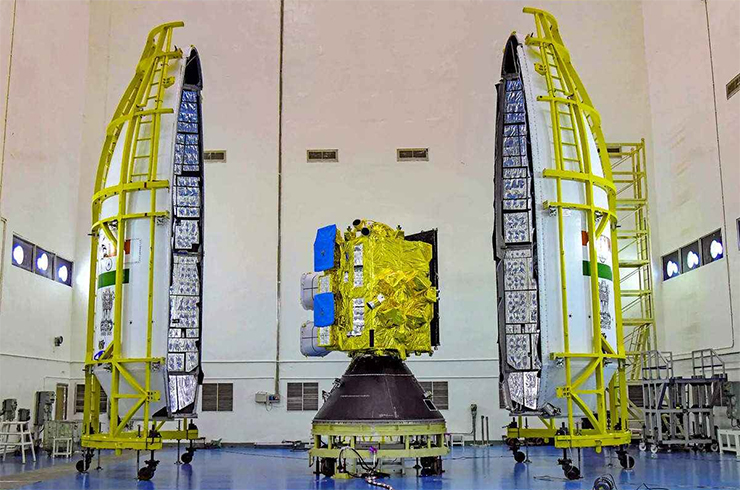India, a land of diverse landscapes and climates, has always been at the mercy of the elements. From scorching summers to monsoon deluges, our lives are intricately woven with the weather.
Enter INSAT-3DS, the latest addition to India’s meteorological arsenal. This advanced weather satellite, set to launch at 5.30 pm on February 17, 2024, from the Satish Dhawan Space Centre (SDSC-SHAR) in Sriharikota, promises to be a game-changer in our quest for accurate weather monitoring and disaster preparedness.
Approximately 20 minutes following its launch, the 420-ton GSLV F14 rocket, previously referred to as the GSLV-Mk2, is set to deploy the INSAT-3DS satellite into a highly elliptical orbit around Earth, known as the Geo Transfer Orbit (GTO). Subsequently, the satellite will utilise its onboard propulsion systems to maneuver itself into a geostationary orbit, which is a circular orbit situated nearly 36,000 km above the planet’s surface.
Purpose and Objectives
INSAT-3DS follows in the footsteps of its predecessors, INSAT-3D and INSAT-3DR. Its mission? To provide round-the-clock meteorological observations, enhance disaster response and ensure continuity of services.
Delving into its Purpose
i) Enhanced Meteorological Observations: INSAT-3DS will keep a vigilant eye on land and surfaces, collecting crucial data for accurate weather predictions
ii) Disaster Response: Swift detection of distress signals during emergencies will aid disaster management efforts
iii) Continuity of Services: The satellite ensures seamless continuation of services offered by the existing INSAT satellites
Key Features & Payloads
- Built on Proven Platform: InSAT-3DS stands tall on ISRO’s reliable I-2k bus platform, providing essential functions like power and propulsion
- Lift-off Mass: With a substantial lift-off mass of 2,275 kilograms, this satellite means business
- Advanced Weather Monitoring Instruments or Payloads – 6-Channel Imager: High-resolution imagery for detailed weather observations and 19-Channel Sounder: Precise soundings of atmospheric parameters
- Communication Payloads – Data Relay Transponder (DRT): Enhances data relay capabilities and Satellite-Aided Search and Rescue (SAS&R) Transponder: Swiftly detects distress signals
INSAT-3DS, the advanced weather satellite is set to launch at 5.30 pm on February 17, 2024, from the Satish Dhawan Space Centre (SDSC-SHAR) in Sriharikota
Application and Impact
The ripple effects of INSAT-3DS will be felt across domains
- Meteorology: Farmers, disaster management agencies and the public will benefit from improved weather forecasting accuracy
- Data Collection: Atmospheric humidity, winds, radiation budget and temperature data will flow continuously
- Communication: Enhanced data relay services will bolster communication networks
- Search and Rescue: Distress signals will not go unnoticed during emergencies

Aerospace Engineering Marvel
India’s space exploration efforts are advancing, with the forthcoming GSLV-F14 mission showcasing their progress. This powerful heavy-lift rocket, created by the Indian Space Research Organisation (ISRO), has an impressive stature of 51.7 metres and a massive launch weight of 420 tons. The GSLV-F14 is equipped with a triple-stage propulsion system, carefully designed to launch payloads into orbit.
Its sturdy construction guarantees stability at launch and accurate control over its path. The rocket’s streamlined form reduces air drag, enabling it to move through the atmosphere effectively.
GSLV-F14 symbolises India’s relentless pursuit of advancing space science. When it ascends from the Satish Dhawan Space Centre (SDSC-SHAR) in Sriharikota, it bears not only its payloads, but also the aspirations of a nation aiming for stellar achievements
- First Stage (GS1): Powered by a solid propellant motor with an impressive capacity of 139 tons; supported by four strap-on stages (L40), each carrying 40 tons of earth-storable liquid propellant
- Second Stage (GS2): Continues the journey with another 40 tons of earth-storable propellant
- Third Stage (GS3): A cryogenic engine filled with 15 tons of liquid oxygen and hydrogen
GSLV-F14 symbolises India’s relentless pursuit of advancing space science. When it ascends from the Satish Dhawan Space Centre (SDSC-SHAR) in Sriharikota, it bears not only its payloads, but also the aspirations of a nation aiming for stellar achievements.
And Now the Bigger Picture
INSAT-3DS is part of the Indian National Satellite (InSAT) system, which has been serving telecommunications, broadcasting, meteorology and search-and-rescue operations since 1983. It is not just a satellite, but also a sentinel watching over our skies, providing vital information to safeguard lives and livelihoods.
In summary, INSAT-3DS is our silent guardian, orbiting high above, ensuring that we are prepared for whatever weather the heavens throw our way.
-The writer is a Defence, Aerospace & Political Analyst based in Bengaluru. He is also Director of ADD Engineering Components, India, Pvt. Ltd, a subsidiary of ADD Engineering GmbH, Germany. You can reach out to him at: girishlinganna@gmail.com
-The author is a Defence, Aerospace & Political Analyst based in Bengaluru. He is also Director of ADD Engineering Components, India, Pvt. Ltd, a subsidiary of ADD Engineering GmbH, Germany. You can reach him at: girishlinganna@gmail.com. The views expressed are personal and do not necessarily carry the views of Raksha Anirveda

















